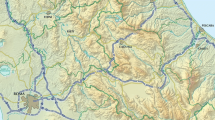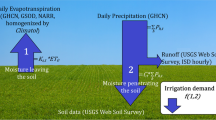Abstract
Soil 222Rn concentrations have been monitored during the 2009 autumn and Spring 2010 rainy periods, in an alluvial soil, resting on a pyroclastic substrate (locally reworked), in the Pietramelara Plain, in Southern Italy. The dry soil diurnal oscillations detected at the site in August 2009 have been found to be present also during the rainy periods of the year, provided, however, that soil moisture conditions are not affected by rainfall infiltration or post storm gravity-driven percolation in the soil depth interval considered. With significant rainfall, the characteristic dry soil diurnal cycle is altered. This rainfall-induced perturbation produces a spike-like signal featuring a sharp rise, with commencement of precipitation, then followed, with persistent and significant rainfall, by an equally sharp drop to very low levels. Both the sharp rise, resulting from capping, and the sharp drop (wash-out), resulting from infiltration, have been found to follow not previously reported second-order trends tied to cumulative rainfall, with very high statistical significance (r 2 > 0.97 for the sharp rise and r 2 > 0.95 for the sharp drop). Furthermore, the sharp drop appears to be tied to wetting front migration of 222Rn-free, or 222Rn-poor, rainwater and to commence when it reaches the soil probe depth, effectively flushing and transferring radon to lower levels of the profile, thus validating previous studies. Low rainfall events (<1–2 mm), however, do not appear to alter significantly the dry soil diurnal cycle. Post rainstorm recovery of soil 222Rn concentrations, in the immediate aftermath of significant rainfall, appears to be very slow and limited. The spike-like pattern induced by rainstorm events poses significant questions as to the interpretation of soil 222Rn concentration time series data in geophysical precursor studies. Likewise the extreme variations resulting from rainfall, and likely affected by rainfall duration, intensity, frequency and spatial variability, pose significant implications in environmental monitoring studies aimed at characterising representative soil 222Rn concentration levels for the wet season.






Similar content being viewed by others
References
Civetta L, Orsi G, Pappalardo L, Fisher RV, Heiken G, Ort M (1997) Geochemical zoning, mingling, eruptive dynamics and depositional processes—the Campanian Ignimbrite, Campi Flegrei caldera, Italy. J Volcanol Geoth Res 75:183–219
Cuoco E, Verrengia G, De Francesco S, Tedesco D (2010) Hydrogeochemistry of Roccamonfina Volcano (Southern Italy). Environ Earth Sci 61:525–538
Davis Weather Instruments (2013) Davis Vantage Pro 2™, technical sheet
De Francesco S, Tommasone Pascale F, Cuoco E, Verrengia G, Tedesco D (2010a) Radon hazard in shallow groundwaters: amplification and long term variability induced by rainfall. Sci Total Environ 408:779–789
De Francesco S, Tommasone Pascale F, Cuoco E, Tedesco D (2010b) Indoor radon seasonal variability at different floors of buildings. Radiat Measur 45(8):928–934
Di Vito MA, Sulpizio R, Zanchetta G, D’Orazio M (2008) The late Pleistocene pyroclastic deposits of the Campanian Plain: new insights into the explosive activity of Neapolitan volcanoes. J Volcanol Geotherm Res 177:19–48
Durridge Company Inc. (2014) RAD7 Electronic Radon Detector (User Manual)
Fujiyoshi R, Kinoshita M, Sawamura S (2005) Variation of 222Rn activity concentration in soil gas at a site in Sapporo, Japan. Environ Geochem Health 27(5–6):539–547
Fujiyoshi R, Sakamoto K, Imanishi T, Sumiyos T, Sawamura S, Vaupotic J, Kobal I (2006) Meteorological parameters contributing to variability in 222Rn activity concentrations in soil gas at a site in Sapporo, Japan. Sci Total Environ 2006(370):224–234
García-Vindas JR (1999) Transport du radon en milieu poreux (expérimentation et modélisation): implication pour la réalisation et l’interprétation de mesures in situ. Tésis de Doctorado. Université de Montpellier II, Montpellier, Français
Garcia-Vindas JR, Monnin MM (2005) Radon concentration measurements in the presence of water and its consequences for Earth sciences studies. Radiat Meas 39:319–322
Ghosh D, Deb A, Sengupta R (2009) Anomalous radon emission as precursor of earthquake. J Appl Geophys 69(2):67–81
King JY, Koizumi Y, Kitagawa Y (1995) Hydrogeochemical anomalie sand the 1995 Kobe earthquake. Science 269:38–39
Pappalardo L, Civetta L, D’Antonio M, Deino A, Di Vito M, Orsi G et al (1999) Chemical and Sr- isotopical evolution of the Phlegrean magmatic system before the Campanian Ignimbrite and the Neapolitan Yellow Tuff eruptions. J Volcanol Geoth Res 91:141–166
Planinic J, Radolic V, Vukovic B (2004) Radon as an earthquake precursor. Nucl Instrum Methods Phys Res 530:568–574
Ryoko F, Moriyoshi K, Sadashi S (2005) Variation of 222Rn activity concentration in soil gas at a site in Sapporo, Japan. Environ Geochem Health 27(5–6):539–547
Schumann RR, Owen DE, Asher-Bolinder S (1988) Weather factors affecting soil-gas radon concentrations at a single site in the semiarid western US. US Geological Survey 54
Segovia N, Valdes C, Pena P, Mena M, Tamez E (2001) Soil radon response around an active volcano. Radiat Meas 34:433–436
Shafique B, Kearfott KJ, Tareen ADK, Rafique M, Aziz W, Naeem SF (2014) Time series analysis and risk assessment of domestic radon: data collected along fault line of dwellings. Indoor Built Environ. doi:10.1177/1420326X14553999
Stranden E, Kolstad AK, Lind B (1984) Radon exhalation—moisture and temperature dependence. Health Phys 47(3):480–484
Szabó KZ, Jordan Gy, Horváth Á, Szabó C (2013) Dynamics of soil gas radon concentration in a highly permeable soil based on a long-term high temporal resolution observation series. J Environ Radioact 214:74–83
Tedesco D, Pece R, Avino R (1996) Radon, pH and temperature monitoring in water wells at Campi Flegrei caldera (southern Italy). Geochem J 30:131–138
Tommasone Pascale F, De Francesco S, Cuoco E, Verrengia G, Santoro D, Tedesco D (2011) Radon hazard in shallow groundwaters II: dry season fracture drainage and alluvial fan upwelling. Sci Total Environ 409:3352–3363
Tommasone Pascale F, De Francesco S, Carbone P, Cuoco E, Tedesco D (2014) Dry soil diurnal quasi-periodic oscillations in soil 222Rn soil concentrations. Radiation Measurements 66:31–41
Virk HS, Singh B (1993) Radon anomalies in soil gas and groundwater as earth-quake precursor phenomena. Tectonophysics 227:215–224
Wakita H, Nakamura Y, Sano Y (1988) Short-term and intermediate-term geochemical precursors. Pure appl Geophys 125:267–278
Walia V, Virk HS, Bajwa BS, Sharma N (2003) Relationships between radon anomalies and seismic parameters in NW Himalaya, India. Radiat Meas 36:393–396
WMO (1996) Guide to meteorological instruments and methods of observation. https://www.wmo.int/pages/prog/www/IMOP/CIMO-Guide.html. Accessed 4 Aug 2014
Author information
Authors and Affiliations
Corresponding author
Rights and permissions
About this article
Cite this article
Tommasone Pascale, F., Carbone, P., De Francesco, S. et al. Rainstorm-induced soil 222Rn concentration spikes observed in Southern Italy. Environ Earth Sci 73, 8177–8187 (2015). https://doi.org/10.1007/s12665-014-3976-0
Received:
Accepted:
Published:
Issue Date:
DOI: https://doi.org/10.1007/s12665-014-3976-0




